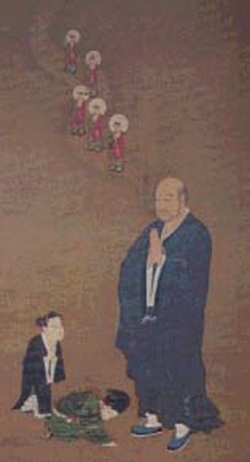Difference between revisions of "Shan-tao"
(Created page with "thumb|250px| <poem> '''Shan-tao''' (Jp. Zendo) [613-681] '''Shan-tao''' is the Chinese patriarch on whom Honen relied for most of his teaching in the Se...") |
|||
| Line 1: | Line 1: | ||
[[File:Shantao.jpeg|thumb|250px|]] | [[File:Shantao.jpeg|thumb|250px|]] | ||
<poem> | <poem> | ||
| − | '''Shan-tao''' (Jp. Zendo) [613-681] | + | '''[[Shan-tao]]''' (Jp. [[Zendo]]) [613-681] |
| − | '''Shan-tao''' is the Chinese patriarch on whom Honen relied for most of his teaching in the Senchakushu. In 641, he visited Tao-ch'o at Hsuan-chung-ssu temple and heard him give a lecture on the Meditation Sutra (Kuan wu-liang-shou ching), which greatly deepened his faith in the Pure Land. Thereafter he went to Ch'ang-an where he disseminated the practice of calling upon the name of Amida Buddha. Shan-tao wrote five works on Pure Land teachings: the Kuan wu-liang-shou ching shu (Commentary on the Meditation Sutra), the Kuan-nien-fa-men (Dharma Gateway of Contemplation), the Wang-sheng-li-tsan (Hymns in Praise of Birth), the Fa-shih-tsan (Liturgical Hymns), and the Pan-chou-tsan (Hymns for Samadhi Wherein All the Buddhas are Present), which, except for the last one, are widely cited in the Senchakushu by Honen. Shan-tao is generally credited for popularizing the nembutsu as the reciting of Amida's name rather than the visualization of him in his Pure Land. | + | '''[[Shan-tao]]''' is the {{Wiki|Chinese}} [[patriarch]] on whom [[Honen]] relied for most of his [[teaching]] in the [[Senchakushu]]. In 641, he visited [[Tao-ch'o]] at Hsuan-chung-ssu [[temple]] and [[heard]] him give a lecture on the [[Meditation Sutra]] ([[Kuan wu-liang-shou ching]]), which greatly deepened his [[faith]] in the [[Pure Land]]. Thereafter he went to [[Ch'ang-an]] where he disseminated the practice of calling upon the [[name]] of [[Amida Buddha]]. [[Shan-tao]] wrote five works on [[Pure Land]] teachings: the [[Kuan wu-liang-shou ching shu]] (Commentary on the [[Meditation Sutra]]), the Kuan-nien-fa-men ([[Dharma]] Gateway of [[Contemplation]]), the Wang-sheng-li-tsan (Hymns in Praise of [[Birth]]), the Fa-shih-tsan (Liturgical Hymns), and the Pan-chou-tsan (Hymns for [[Samadhi]] Wherein All the [[Buddhas]] are Present), which, except for the last one, are widely cited in the [[Senchakushu]] by [[Honen]]. [[Shan-tao]] is generally credited for popularizing the [[nembutsu]] as the reciting of [[Amida's]] [[name]] rather than the [[visualization]] of him in his [[Pure Land]]. |
</poem> | </poem> | ||
{{R}} | {{R}} | ||
Revision as of 16:16, 17 September 2013
Shan-tao (Jp. Zendo) [613-681]
Shan-tao is the Chinese patriarch on whom Honen relied for most of his teaching in the Senchakushu. In 641, he visited Tao-ch'o at Hsuan-chung-ssu temple and heard him give a lecture on the Meditation Sutra (Kuan wu-liang-shou ching), which greatly deepened his faith in the Pure Land. Thereafter he went to Ch'ang-an where he disseminated the practice of calling upon the name of Amida Buddha. Shan-tao wrote five works on Pure Land teachings: the Kuan wu-liang-shou ching shu (Commentary on the Meditation Sutra), the Kuan-nien-fa-men (Dharma Gateway of Contemplation), the Wang-sheng-li-tsan (Hymns in Praise of Birth), the Fa-shih-tsan (Liturgical Hymns), and the Pan-chou-tsan (Hymns for Samadhi Wherein All the Buddhas are Present), which, except for the last one, are widely cited in the Senchakushu by Honen. Shan-tao is generally credited for popularizing the nembutsu as the reciting of Amida's name rather than the visualization of him in his Pure Land.
